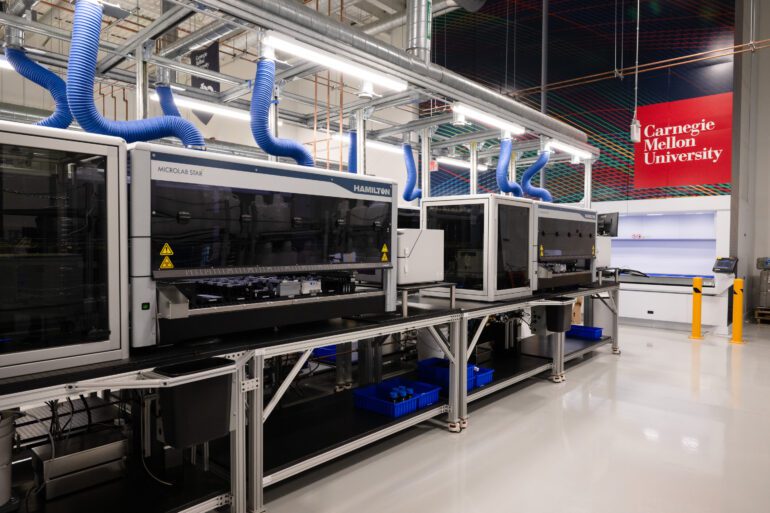TL;DR:
- Carnegie Mellon University’s Coscientist, powered by LLMs, redefines laboratory experimentation.
- Coscientist enhances research speed, precision, and efficiency with advanced reasoning and code generation.
- Access to research tools like internet search and robotic platforms empowers Coscientist.
- It can plan chemical synthesis, navigate hardware documentation, and solve optimization problems.
- Collaboration between humans and AI promises breakthrough discoveries.
- A partnership with Emerald Cloud Lab expands its practical applications.
- Ethical considerations are addressed to ensure responsible AI-enabled science.
Main AI News:
Innovation in scientific research knows no bounds, and the dawn of Artificial Intelligence (AI) has ushered in a new era of possibilities. At Carnegie Mellon University, a groundbreaking endeavor led by Gabriel Gomes, PhD, an assistant professor of chemistry and chemical engineering, alongside his accomplished team of chemical engineering doctoral students Daniil Boiko and Robert MacKnight, has given birth to a marvel known as Coscientist. This state-of-the-art system harnesses the remarkable capabilities of Large Language Models (LLMs), including OpenAI’s GPT-4 and Anthropic’s Claude, to transform the landscape of laboratory experimentation.
In their recent publication titled “Autonomous chemical research with large language models” in the prestigious journal Nature, the researchers unveil the prowess of Coscientist and its architectural intricacies. This intelligent lab partner, powered by LLMs, has the ability to conceptualize and remotely execute complex chemistry experiments. The implications of this innovation are nothing short of astounding.
Coscientist operates at the nexus of human ingenuity and AI-driven precision. It empowers scientists to design and execute experiments with unprecedented speed, precision, and efficiency, all while ensuring superior outcomes compared to traditional human-centered approaches. The system’s proficiency shines through in advanced reasoning, experimental design, and high-quality code generation, thus addressing intricate scientific challenges.
The crux of Coscientist’s capabilities lies in its access to an array of research tools, including internet and documentation search, coding environments, and robotic experimentation platforms. This arsenal enables the system to accomplish a spectrum of tasks, from planning chemical synthesis for known drugs and compounds to navigating hardware documentation, orchestrating processes in cloud labs, managing liquid handling instruments, handling multi-module tasks, and solving optimization problems by leveraging existing data.
For instance, researchers can task Coscientist with the quest to discover a compound with specific properties. The system, armed with its extensive knowledge base, scours the web, references technical documentation, and compiles relevant information to propose a well-informed experimental blueprint. This blueprint is then seamlessly executed by automated instruments within the laboratory environment.
The potential ramifications of intelligent agent systems like Coscientist are profound. The synergy between humans and machines promises to unlock untold discoveries, uncharted therapeutic avenues, and novel materials. While the exact nature of these breakthroughs remains uncertain, the collaboration between humans and AI is poised to reshape the research landscape.
To underscore the practicality of Coscientist in automated lab settings, the Carnegie Mellon team has forged a partnership with the Emerald Cloud Lab (ECL). This remote research facility, founded by Carnegie Mellon alumni, offers access to a diverse array of over 200 pieces of equipment, spanning cell culture, sample preparation, mass spectrometry, bioassays, and much more, all controlled from a unified software interface. The imminent establishment of a Carnegie Mellon cloud lab will facilitate experiments across diverse disciplines, from genetic engineering and synthetic biology to structural biology, biochemistry, and physical chemistry. Moreover, plans are afoot to incorporate support for emerging disciplines like cell biology and medicinal chemistry. Gabriel Gomes is committed to advancing the technologies outlined in Nature to propel the capabilities of cloud labs at Carnegie Mellon and similar autonomous laboratories in the future.
David Berkowitz, the chemistry division director for the National Science Foundation, lauds the efforts of Gomes and his team, describing Coscientist as a “hyper-efficient lab partner” that surpasses the sum of its components. This AI-enabled scientific ally promises genuine utility and transformative potential.
In a world driven by innovation, it is crucial to address safety concerns associated with AI, and Gomes’ team has taken this responsibility seriously. They have meticulously examined the possibility of Coscientist being used for designing experiments involving hazardous chemicals or controlled substances, a topic explored in detail within the paper’s supplementary information. Gomes emphasizes the importance of acknowledging potential pitfalls and proactively implementing safeguards in the realm of AI-enabled science.
As the boundaries of scientific exploration continue to expand, the emergence of AI-powered lab partners like Coscientist underscores the profound impact of technology on the future of research. With visionary scientists at the helm and a commitment to ethical, safe, and responsible innovation, the possibilities are limitless. The partnership between humans and machines is poised to redefine the frontiers of scientific discovery.
Conclusion:
The development of Coscientist represents a significant advancement in AI-enabled scientific research. Its potential to revolutionize laboratory experimentation, enhance collaboration between humans and machines, and drive transformative discoveries underscores the profound impact of AI on the research market. Researchers and institutions should consider the ethical implications while harnessing the capabilities of such AI-driven systems to ensure responsible and innovative scientific progress.

